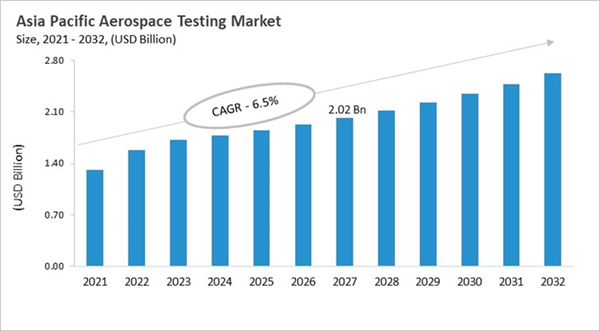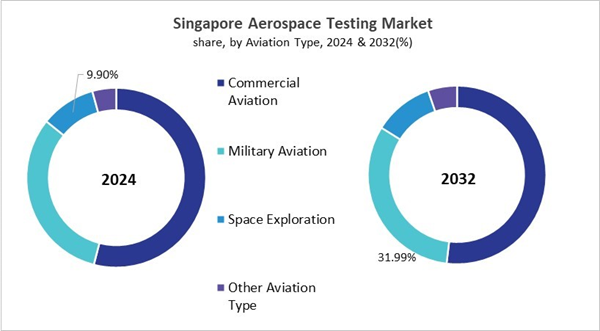The Asia Pacific Aerospace Testing Market is expected to witness market growth of 5.1% CAGR during the forecast period (2025-2032).
The China market dominated the Asia Pacific Aerospace Testing Market by country in 2024, and is expected to continue to be a dominant market till 2032; thereby, achieving a market value of $1.11 billion by 2032. The Japan market is registering a CAGR of 4.2% during 2025-2032. Additionally, the India market is expected to showcase a CAGR of 6.1% during 2025-2032. The China and Japan led the Asia Pacific Aerospace Testing Market by Country with a market share of 46.4% and 14.9% in 2024.The Malaysia market is expected to witness a CAGR of 9.5% during throughout the forecast period.
The aerospace testing market in the Asia Pacific region has grown quickly because of industrialization, more people flying, and bigger goals in defense and space. Governments in the area have made their regulatory frameworks stronger and put money into big infrastructure projects. For example, China plans to build about 15 new testing centers, and Singapore's Seletar Aerospace Park will combine testing, MRO, and training. OEMs and MRO providers, such as GMF AeroAsia and SIAEC, have increased their in-house testing to help with compliance and manufacturing in the region. This change has allowed the area to go from relying on outside facilities to creating a wide range of testing environments that include structural, material, avionics, propulsion, and software validation. Non-destructive testing (NDT), digitalization through AI and IoT, and simulation tools are changing the way things work by making them safer, more efficient, and better at predicting when maintenance is needed.
Governments, OEMs, MRO companies, and specialized providers all compete in the Asia Pacific aerospace testing market. National agencies compete to get more investment and make domestic testing ecosystems stronger. At the same time, OEM-linked organizations are expanding their own facilities to make sure they follow the rules and get certifications faster. Independent service providers focus on niche areas such as advanced NDT and AI-driven diagnostics, differentiating through expertise and turnaround times. Strategic clustering, like Singapore's Seletar Aerospace Park, encourages people to work together, share resources, and grow their skills. Asia Pacific has become a strong and competitive aerospace testing hub that is ready for more growth in commercial, defense, and space aviation. This is thanks to government-led infrastructure growth, OEM integration, and the use of new technologies.
The China market dominated the Asia Pacific Aerospace Testing Market by country in 2024, and is expected to continue to be a dominant market till 2032; thereby, achieving a market value of $1.11 billion by 2032. The Japan market is registering a CAGR of 4.2% during 2025-2032. Additionally, the India market is expected to showcase a CAGR of 6.1% during 2025-2032. The China and Japan led the Asia Pacific Aerospace Testing Market by Country with a market share of 46.4% and 14.9% in 2024.The Malaysia market is expected to witness a CAGR of 9.5% during throughout the forecast period.
The aerospace testing market in the Asia Pacific region has grown quickly because of industrialization, more people flying, and bigger goals in defense and space. Governments in the area have made their regulatory frameworks stronger and put money into big infrastructure projects. For example, China plans to build about 15 new testing centers, and Singapore's Seletar Aerospace Park will combine testing, MRO, and training. OEMs and MRO providers, such as GMF AeroAsia and SIAEC, have increased their in-house testing to help with compliance and manufacturing in the region. This change has allowed the area to go from relying on outside facilities to creating a wide range of testing environments that include structural, material, avionics, propulsion, and software validation. Non-destructive testing (NDT), digitalization through AI and IoT, and simulation tools are changing the way things work by making them safer, more efficient, and better at predicting when maintenance is needed.
Governments, OEMs, MRO companies, and specialized providers all compete in the Asia Pacific aerospace testing market. National agencies compete to get more investment and make domestic testing ecosystems stronger. At the same time, OEM-linked organizations are expanding their own facilities to make sure they follow the rules and get certifications faster. Independent service providers focus on niche areas such as advanced NDT and AI-driven diagnostics, differentiating through expertise and turnaround times. Strategic clustering, like Singapore's Seletar Aerospace Park, encourages people to work together, share resources, and grow their skills. Asia Pacific has become a strong and competitive aerospace testing hub that is ready for more growth in commercial, defense, and space aviation. This is thanks to government-led infrastructure growth, OEM integration, and the use of new technologies.
Testing Type Outlook
Based on Testing Type, the market is segmented into Material Testing, Structural/Component Testing, Environmental Testing, Electromagnetic Compatibility (EMC) Testing, Software Testing, and Other Testing Type. Among various China Aerospace Testing Market by Testing Type; The Material Testing market achieved a market size of USD $259.2 Million in 2024 and is expected to grow at a CAGR of 3.1 % during the forecast period. The Electromagnetic Compatibility (EMC) Testing market is predicted to experience a CAGR of 5.2% throughout the forecast period from (2025 - 2032).Aviation Type Outlook
Based on Aviation Type, the market is segmented into Commercial Aviation, Military Aviation, Space Exploration, and Other Aviation Type. With a compound annual growth rate (CAGR) of 7.5% over the projection period, the Commercial Aviation Market, dominate the Singapore Aerospace Testing Market by Aviation Type in 2024 and would be a prominent market until 2032. The Space Exploration market is expected to witness a CAGR of 9.4% during 2025-2032.Country Outlook
Japan’s aerospace testing market plays a critical role in the Asia Pacific region, supported by its strong aerospace industry, government-backed R&D, and precision engineering expertise. With contributions from major firms, rigorous standards set by JAXA and METI, and alignment with global supply chains, Japan ensures high safety and performance levels. Key drivers include sustainable aviation initiatives like hydrogen propulsion, digitalization through AI and digital twins, and a growing MRO sector. Trends such as non-destructive testing, eVTOL validation, and environmental simulations are reshaping processes, while VR-based tools enhance efficiency. Competition is strong, with OEMs maintaining in-house testing, independents offering specialized services, and niche firms targeting unmanned and satellite systems. Collaborations with research institutions and strategic acquisitions further expand capabilities. With its focus on sustainability, innovation, and regulatory compliance, Japan’s aerospace testing market is poised for continued growth and remains a cornerstone of the regional aerospace ecosystem.List of Key Companies Profiled
- Element Materials Technology (Temasek Holdings)
- SGS S.A.
- Intertek Group PLC
- Applus+ Group
- The Boeing Company
- Lockheed Martin Corporation
- Rolls-Royce Plc (Rolls-Royce Holdings Plc)
- Airbus SE
- Mistras Group, Inc.
- Bureau Veritas S.A.
Market Report Segmentation
By Application
- Aircraft Structures
- Avionics & Electronics
- Propulsion Systems
- Space Systems
- Interiors
By Testing Type
- Material Testing
- Structural/Component Testing
- Environmental Testing
- Electromagnetic Compatibility (EMC) Testing
- Software Testing
- Other Testing Type
By End Use
- OEMs
- MROs (Maintenance, Repair & Overhaul)
- Airlines & Defense Operators
- Government & Space Agencies
- Other End Use
By Aviation Type
- Commercial Aviation
- Military Aviation
- Space Exploration
- Other Aviation Type
By Country
- China
- Japan
- India
- South Korea
- Singapore
- Malaysia
- Rest of Asia Pacific
Table of Contents
Chapter 1. Market Scope & Methodology
Chapter 2. Market at a Glance
Chapter 3. Market Overview
Chapter 8. Competition Analysis - Global
Chapter 9. Value Chain Analysis of Aerospace Testing Market
Chapter 11. Asia Pacific Aerospace Testing Market by Application
Chapter 12. Asia Pacific Aerospace Testing Market by Testing Type
Chapter 13. Asia Pacific Aerospace Testing Market by End Use
Chapter 14. Asia Pacific Aerospace Testing Market by Aviation Type
Chapter 15. Asia Pacific Aerospace Testing Market by Country
Chapter 16. Company Profiles
Companies Mentioned
- Element Materials Technology (Temasek Holdings)
- SGS S.A.
- Intertek Group PLC
- Applus+ Group
- The Boeing Company
- Lockheed Martin Corporation
- Rolls-Royce Plc (Rolls-Royce Holdings Plc)
- Airbus SE
- Mistras Group, Inc.
- Bureau Veritas S.A.










